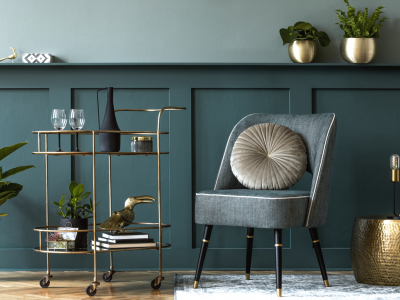
Wood Wall Paneling: How to Paint it Right
Walls covered in wood can look warm and cozy or worn and dated, depending on the paneling’s quality and your style perspectives. If you have wood paneling that has a cheap veneer and you’re not a fan of its retro vibe, painting over it might be an excellent, budget-friendly option.
Just make sure you’re confident about your decision since stripping paint from paneling is extremely difficult and may only be possible on solid hardwood surfaces.
Remember that when paneling is installed, the wood pieces are butted together and held in place with small finishing nails. All the holes and cracks will need to be filled to create a smooth surface. Future temperature and humidity changes might create hairline cracks in the painted surface where the seams join, and the wall meets the trim.
If you’ve decided that painting over paneling is your best option, follow these steps for the best results:
1. Clean
Use a damp rag to remove dust and any cobwebs from the surface. Suppose the paneling has grimy fingerprints or has been exposed to cooking oils, hairspray, or other airborne chemicals. In that case, it's essential to wash it with a TSP solution, diluted dishwashing detergent, or another suitable cleaner to help ensure that primer and paint can adhere to the surface.
2. Fill
Any irregularities in the wood will be accentuated by paint. Use wood putty and a putty knife to fill nail holes, small joint seams, and any scratches or scrapes. Apply paintable caulk in the corners, where the paneling meets the baseboard, and around windows and doors. Caulk can also be used to fill larger gaps between paneling pieces.
3. Sand
Sand down any spots where you applied wood putty to ensure the surface is level. Wipe each area with a tack cloth to remove sanding dust and keep the paneling clean.
Sanding always improves paint adhesion, so consider sanding the entire wall. Some painters skip this step, but it depends on the type of paneling you’re painting. The harder and slicker the surface, the more critical it is to use 180–220 grit sandpaper to rough it up.
4. Prime
Primer serves several purposes. It can help improve paint adhesion, reduce the number of paint coats required, and prevent wood stains from bleeding through your paint. Be sure to select a primer that includes a stain blocker, especially if you’re painting over wood that has knots.
Ask your paint supplier to recommend the best primer for your surface. Water-based products are often better for solid wood paneling, but oil-based primers are preferable on slicker veneer surfaces.
Begin with a 2-inch angled brush to cover the trim and cut in at the wall’s corners and edges. Switch to a roller to apply a thin coat of primer to the rest of the surface, keeping your brush handy to wipe away any drips. Once the primer has dried, apply a second coat.
5. Paint
Apply two thin coats of paint in the same manner as the primer, using a brush and roller. However, it’s usually preferable to use a glossier finish paint on the trim than the walls, so the trim stands out and it's easier to wipe it down and keep it clean.
